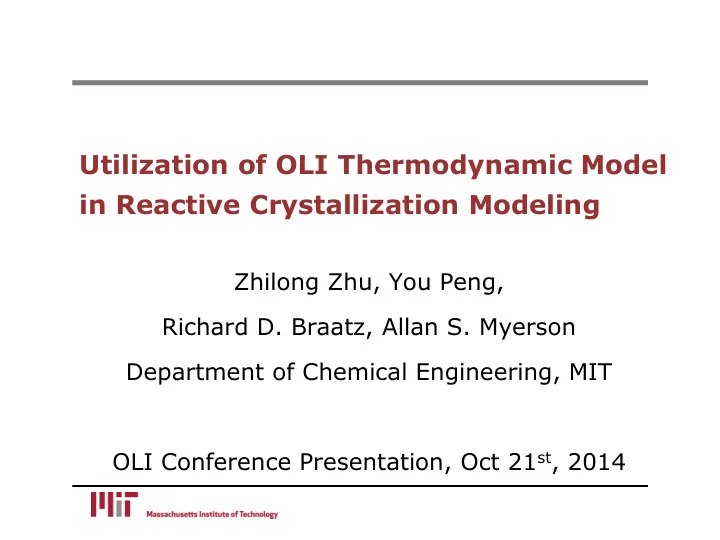

Utilization of OLI Thermodynamic Model in Reactive Crystallization Modeling Zhilong Zhu, You Peng, Richard D. Braatz, Allan S. Myerson Department of Chemical Engineering, MIT OLI Conference Presentation, Oct 21 st , 2014
Outline • Introduction to crystallization – Quality attributes: CSD, purity, polymorph, yield – Modeling: population balance model and thermodynamic model • Why OLI thermodynamic model? – Mixed Solvent Electrolyte (MSE) model • Application in reactive crystallization – OLI databank construction and result – Integration with Matlab – Simulation result Page 2
Introduction to crystallization • Crystallization is an important separation and purification process • Key attributes in crystallization – Crystal size distribution (CSD) – Crystal purity – Crystal polymorphs b # p articles/vo l a f ( x d x ) – Crystal yield a # density b f ( x ) x Crystal size Page 3
Crystallization methods • Driving force: supersaturation c c ( T ) Metastable sat S Solubility limit c ( T ) sat curve Labile zone Nucleation • Methods: – Cooling Undersaturated – Antisolvent addition – Evaporation – Chemical reaction Metastable zone Growth Temperature A.S. Myerson, Handbook of Industrial Crystallization, 1993 Page 4
Population Balance Model (PBM) Conservation equation for number density, f – spatially homogenous – one independent crystal internal coordinate, x – constant volume – batch process PBM: G f f B Crystals t x Crystal Nucleation growth rate rate Total mass = solute mass + crystal mass 1 st order partial integro-differential equation Page 5
Thermodynamic model in crystallization Crystal growth rate Solubility / Supersaturation equilibrium ~ driving force Nucleation rate For multi-species, ionic, For most simple organic system concentrated system Concentration c c ( T ) sat S a c ( T ) i sat i ,w h ere a m S i i i k sp c sat ( T ) Need a rigorous electrolyte Temperature model to predict i Page 6
OLI Thermodynamic models • We chose to use OLI Mixed Solvent Electrolyte (MSE) model because – First-principles model – Agrees better with our test cases • The MSE models the excess Gibbs free energy ex ex ex ex G G G G L R S R II Short Long Ionic Range Range Interaction ex G ln k n R T k T , P n , j , j k Page 7
Integration with Matlab via Excel Matlab GUI model file from Initial values OLI Analyzer Supersaturation PBM (scaling tendency) ode45 solver Solution Speciation (iterative) composition Update solution composition via Excel Macro CSD plots Excel data storage speed: ~25 seconds for 300 OLI calls Page 8
OLI application in reactive crystallization Scaling Tendency for CaSO 4 .2H 2 O in OLI OLI Analyzer # of solids: 18 Existing OLI databank does not # of liquids: 27 have all the parameters in the # of parameters: 38 MSE model for our system We carried out solubility experiments at various conditions We did regression using OLIREG for missing parameters Page 9
Parity plot for CaSO 4 . 2H 2 O solubility 0.20 Model predicted solubility 0.15 (wt%) 0.10 0.05 0.00 0.00 0.05 0.10 0.15 0.20 Solubility from literature data (wt%) (1) Taperova, A. A. Zh. Prikl. Khim 18 (1940): 643. (2) Taperova, A. A., and N. M. Shulgiva. Zh. Prikl. Khim 18 (1945): 521. (3) Kurteva, O. I., and E. B. Brustkus. Zh. Prikl. Khim 34 (1961): 1714. Page 10
Batch reactive crystallization simulation Provide C 0 , T , and initial CSD Transform the PDE into ODEs d f G ( x t , ) f ( x t , ) B f ( x t , ), x t , d t x d x G ( x t , ) d t Solve the ODEs using Matlab - calculate drop in concentration - update Excel - trigger OLI Engine - return scaling tendency - next time step Page 11
Reactive crystallization simulation result Matlab GUI Page 12
Summary • Model for reactive crystallization needs accurate thermodynamics • OLI MSE model provides a good supersaturation prediction for our electrolyte system • OLI Engine was coupled with Matlab via Excel to simulate batch reactive crystallization Page 13
Recommend
More recommend